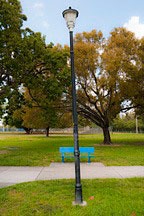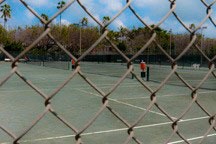
Parks are essential elements of vibrant and sustainable neighborhoods, while recreation centers get most of their DNA from super-sizing and sprawl. Both parks and recreation centers foster fitness activities, but there are several differences crucial to the health of the neighborhood and the greenness of the city.
Parks are places where people can enjoy countless outdoor activities. See the patch of grass the people above are sitting on? Earlier that morning, it might have been used for a pick-up softball game. After these people leave, a few kids might kick around a soccer ball. Later in the day, you might see a couple young lovers on a stroll along the shadows at the edge of the field. Most activities are relatively unplanned. Most often, park recreation planning goes something like “hey, let’s go down to the park and see if anyone wants to play ball,” like the guys in the picture below. You don’t have to pay admission or get permission to go to the park.
Recreation centers, other than the fact that they also involve physical activity, are quite the opposite. Recreation centers have extensive facilities for certain organized sports: a swimming pool, baseball diamonds, soccer fields, tennis courts, basketball courts, etc.
Because recreation centers require major investments, they often have to charge admission of some sort to help pay back that investment. You also may need to be a member of the recreation center’s association to gain access. As a result, many of the activities in recreation centers occur behind walls or chain-link fences.


Once, a basketball court or two, a baseball diamond, a couple tennis courts, or even a soccer field were often tucked around the edges of many parks. More recently, however, our penchant for super-sizing everything, plus our deference to major sporting events that might happen only once or twice a year have resulted in the need to expand one or two of everything to dozens of everything. Two tennis courts are now no longer good enough... gotta have a couple dozen in order to possibly host a city-wide tournament at some point in the future. One baseball diamond? Forget it... gotta have eight so you can host a tournament there, too. There are several hidden problems with these super-sized recreation centers:
You can’t walk your dog on the tennis courts. Or in the swimming pool. Or on the basketball court. A tennis-focused recreation center, for example, is only useful to people who play tennis. Because recreation centers focus on single-use recreational uses (like sprawl does with land use in general,) they eliminate fields for dog-walking, tossing a frisbee, pick-up games of whatever you want to play, or just laying in the sun or sitting on the park bench watching the world go by.
Do we need specific-use recreational facilities like tennis courts, swimming pools, etc.? Of course. It’s just a question of proportion.

Here’s one of the problems with proportion: If only a fraction of the population within walking distance of a recreation center play tennis, then building enough tennis courts to hold a major tournament means that most of the people playing on those courts will have to drive to get there. There are several sustainability ramifications here: Most obvious is the fact that you’re burning a lot of gas to get there. But you also have to surround the recreation center with lots of parking for all the cars. Plus, you’re clogging the streets of the neighborhood with traffic. Also, because the recreation center doesn’t attract nearby neighbors for all the general-use stuff like dog-walking, you’re starving the neighborhood streets of pedestrians that would otherwise make the neighborhood more vibrant and safe as I described in this post.

There are a couple rules of thumb distinguishing between parks and recreation centers: First, parks are made up primarily of multi-use fields. This means that less than half of the space in a park should be dedicated to single-use recreational facilities. A much better number is less than one-fourth single use, with the vast majority being multi-use. Many great parks are completely multi-use.
There’s also the Grandstand Rule: If an activity needs a grandstand, it’s probably drawing a crowd from further around than just the neighborhood.
So is there a place for a recreation center? Yes: Out on the highway somewhere. They are large, expensive, sprawl-based facilities, but if your community can’t do without one, then put it where it belongs: where lots of traffic can get to it quickly and easily. But by all means, don’t put it in a neighborhood. It’s not a good neighbor. It needs to keep to itself.

Parks, on the other hand, are necessary parts of a sustainable neighborhood. Everybody should be within a five-minute walk of a park, and smaller playgrounds for kids should be scattered throughout the neighborhood so that every kid is within a two-minute walk of a playground. Town planners such as those at the Congress for the New Urbanism, of which I’m a member, support these park principles.

There is a growing threat to neighborhood parks today: they’re increasingly being eaten up for single-use recreational activities, so in effect, they’re being transformed into recreation centers right under our very noses! My own Flamingo Park in Miami Beach is in grave danger of this fate. Already, so much of the land has been given over to single-use activities that there are only two general-use fields left, and they constitute a ridiculously low percentage of the entire park. Now, the tennis advocates want to take one of those two fields so that they can add to the seventeen tennis courts they have already! Might as well change the name to the Flamingo Rec Center and build a new parking lot on the other remaining field to handle all the extra traffic!
~Steve Mouzon
Note: If any of the images above are useful to you, they’re available at high resolution for printing or download on my Zenfolio site. Just click on the image and it’ll take you there.
Legacy Comments:
Wednesday, April 14, 2010 - 09:48 AM
Anonymous
Steve, in planner parlance the difference is between programmed and unprogrammed recreational space. And I couldn't agree more. Our lives are already over-programmed!
Ann
Wednesday, April 14, 2010 - 12:04 PM
Nancy Bruning
Steve, as usual you hit the nail on the head. Where on earth did you get these radical ideas from? I'd add: the possibility of people-led programming (in public health parlance) to encourage and guide people who can't or won't be active on their own. For example, people lead groups of people through structured outdoor fitness programs (the extreme being boot-camp-like classes) using existing park features and furniture such as benches -- see the Fitness Alfresco page on my website.
Wednesday, April 14, 2010 - 04:48 PM
Dan Cotter
If Steve says the place for anything is on a highway somewhere, you KNOW he really hates it! Joking. Might we amend that by saying that the place for a rec center could be in a tourism district in a high density city center, accessible by public transit? I think you've picked up on an interesting phenomena... A rec center sounds more closely affiliated with a stadium or a museum, a completely different animal from a park, and should be treated as such... So I see no reason it couldn't still enhance a city center, if it were treated as what it is.
Wednesday, April 14, 2010 - 08:04 PM
Steve Mouzon
Thanks, Ann! Nancy, you're exactly right... your Fitness Alfresco ideas played prominently into this post. I'm going to blog on Fitness Alfresco shortly, but want to devote an entire post to the ideas, since they're so important. Dan, you bring up important issues. Like any other single-use district, recreation centers cast a huge "pedestrian shadow," and are therefore more suitable for boundaries of vibrant areas, rather than the centers of them. But this idea, like Fitness Alfresco, is important enough that it deserves further conversation... Thanks!
Tuesday, April 20, 2010 - 12:49 PM
Mary Vogel
I just sent the URL to this blog to my friend Carole who has been battling for years to keep a skateboard park from overtaking a lovely park filled with large native oaks next to a senior living center.
Tuesday, April 20, 2010 - 04:42 PM
give me a break
And why would you want to walk your dog on a basketball court? Do you think dogs should be allowed on the beach?
Wednesday, April 21, 2010 - 09:30 PM
Steve Mouzon
Thanks, Mary! Good luck to your friend! "give me a break," what I'm saying is that parts of parks that are taken over for single uses, like basketball courts, tennis courts, and swimming pools are no longer available for other uses like walking your dog. Open fields can be used for countless activities, from yoga to running to football to soccer to dog-walking to strolling or just lying in the grass. Or many other things I haven't named here. But single-use places like tennis courts are only usable for the single thing for which they're built. A much less effective use of land, for a much smaller segment of the population, it seems to me.





